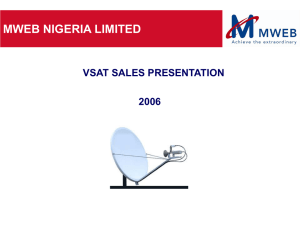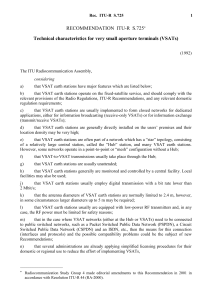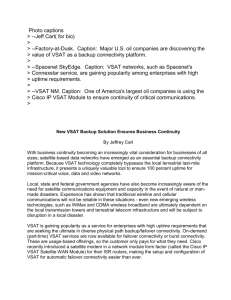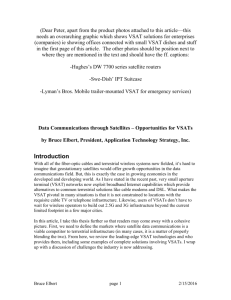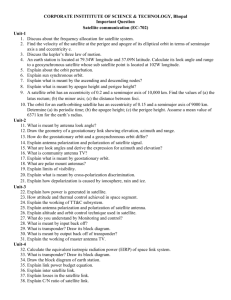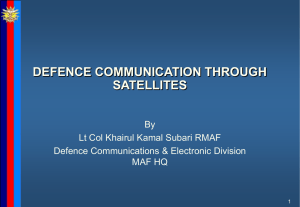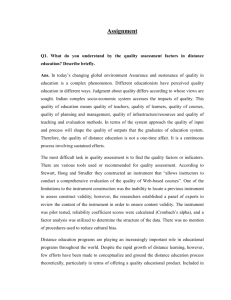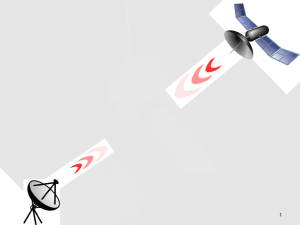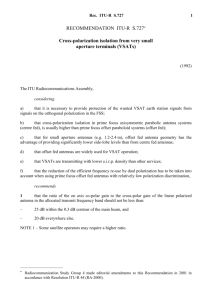Satellite Communication – VSAT
advertisement
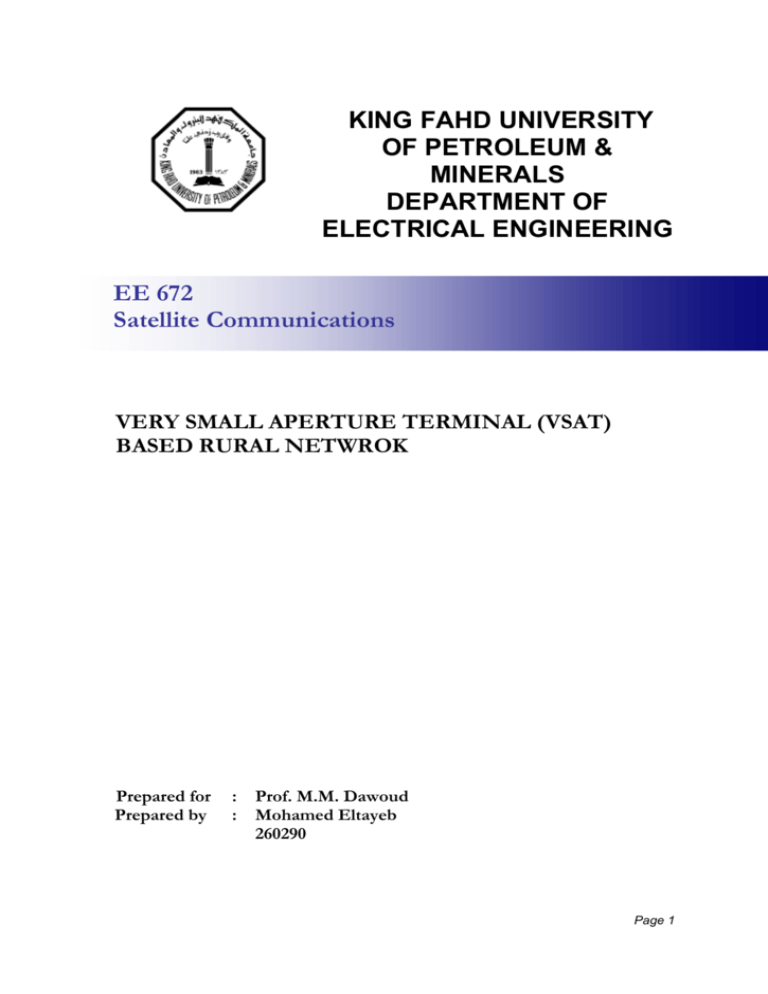
KING FAHD UNIVERSITY OF PETROLEUM & MINERALS DEPARTMENT OF ELECTRICAL ENGINEERING EE 672 Satellite Communications VERY SMALL APERTURE TERMINAL (VSAT) BASED RURAL NETWROK Prepared for Prepared by : : Prof. M.M. Dawoud Mohamed Eltayeb 260290 Page 1 CONTENTS 1.0. INTRODUCTION 3 2.0. VSAT Overview 2.1. VSAT specifications 2.1.1 Indoor Unit (IDU) 2.1.2 Outdoor Unit (ODU) 2.2 VSAT services 2.3 VSAT Topology 2.3.1 Star Topology 2.3.2 Mesh Topology 2.3.3 Hybrid Topology 3 4 4 4 4 5 5 5 6 3.0 Proposed System 3.1 System Description 3.2 System Parameters and Capacity 3.2.1 System Parameters 3.2.2 System Capacity 3.3 Propagation Effects 6 6 6 6 7 8 4.0 System Design 4.1 Link budget for inbound link 4.1.1 VSAT Uplink C/N 4.1.2 Satellite Downlink C/N 4.2 Link budget for Outbound link 4.2.1 Hub Uplink C/N 4.2.2 Satellite Downlink C/N 4.3 Approximate Delay Considerations 4.4 Hub Earth Station 4.5 VSAT Antenna 4.6 Multiple Access Scheme 8 8 8 9 10 10 10 11 12 12 13 5.0 System Applications with respect to Remote Areas 5.1 Rural/Remote Areas Scenarios 14 14 6.0 System Application Scenario (HASSAI) 16 7.0 Conclusion 19 8.0 References 20 Page 2 1.0 Introduction Many inhabitants of rural remote areas currently have no way of communicating locally or with the outside world as no services are available in their region. As a solution, a VSAT associated with a local loop is employed. In these areas, the required number of lines typically ranges from 20 to 500 per local loop. Rural users do not generate the same amount of revenue as urban users do, thus lowering incentives for rural telecommunications investment with service to those regions delayed as long as possible. Voice and data communications are essential to the economic development of a region, and it has been shown that traffic increases rapidly as soon as the service is available. A VSAT system, combined with the Demand Assigned Multiple Access (DAMA) infrastructure, collocated with a wireless local loop (WLL) will be designed in this project, but emphasis will be more on the VSAT system. System design considerations include the type of traffic which can be carried, traffic rate, VSAT network architecture/topology, modulation scheme used, multiple access scheme used, foot print, link budget and ground segment antenna design. 2.0 VSAT (Very Small Aperture Terminal) Overview VSAT (Very Small Aperture Terminal) is a satellite-based communications service that offers businesses and government agencies flexible and reliable communications solutions, both nationally and internationally, on land and at sea. VSATs are most effective where the existing telecommunications infrastructure is unreliable or where the vast size of the country or nature of the terrain prevents the use of conventional land line or LOS radio links. However, even in highly developed countries VSAT can provide effective data distribution at costs highly competitive with the terrestrial network. VSAT networks provide: i. Rapid, reliable satellite transmission of data, voice and video and an ability to allocate resources (bandwidth and amplification power) to different users over the coverage region as needed. ii. VSAT industry is offering fixed network solutions that can provide a full suite of services at reasonable price. iii. iv. Easy to provide point-to-multipoint (broadcast), multipoint-to-point (data collection), point-to-point communications and broadband multimedia services. Flexible in the sense that it adapts to business and traffic environments. Page 3 v. vi. Easy to manage network. VSAT network is much more cost-effective than leased line. Pay-bymile concept in case of leased line sends the cost spiraling upwards, especially if population is scattered. VSATs are serviced not only in cases where the land areas are difficult to install, say in the case of remote locations, water areas, and large volumes of air space. An ability to have direct access to users and user premises. vi. vii. 2.1 Specification VSAT is a term widely used in the satellite industry to describe an earth station that is installed on the ground to receive communications from a satellite or to communicate with other ground stations by transmitting to and receiving from satellite spacecraft. They are characterized with small antennas, typically 2 meter diameter and low power consumption. 2.1.1. Out Door Unit The ODU, so named because the components reside outdoors, includes; the antenna ( typically from 0.6m - 3m in diameter), equipped with a feed system capable of receiving and transmitting, a microwave radio, also known as a HPA High Power Amplifier, and an LNA (low noise amplifier) used to convert the signal gathered by the feed. 2.1.2. Indoor Unit (IDU) The indoor unit is typically composed of a single unit called a modem. A satellite modem is different than a telephone modem, and is used to convert the data, video, or voice generated by the customer application for transmission over satellite. The modem takes the signals from your computer, phone or other device and changes them so they can be sent to the ODU which transmits them out to the satellite and eventually to other ground stations. 2.2 VSAT Services i. Interactive real time application: - Point of Sale/retail/Banking (eg. ATM, The peak traffic requirements of a network of say 100 ATMs all trying to communicate in a single 5 second period can be met with a single satellite 64Kb/s circuit shared on a burst mode TDMA basis.) - Corporate data (X.25 protocol) ii. Telephony Page 4 - Rural: individual subscribers - Corporate Telephony iii. Intranet, Internet and IP infrastructure - Multimedia delivery (eg. video streaming) - Interactive distance learning/ training iv. Direct-to-home - Broadband Internet access for consumers and businesses 2.3 VSAT Topology 2.3.1. Star The hub station controls and monitors can communicate with a large number of dispersed VSATs. Generally, the Data Terminal Equipment and 3 hub antenna is in the range of 6-11m in diameter. Since all VSATs communicate with the central hub station only, this network is more suitable for centralized data applications. Figure 1: VSAT star topology 2.3.2. Mesh A group of VSATs communicate directly with any other VSAT in the network without going through a central hub. A hub station in a mesh network performs only the monitoring and control functions. These networks are more suitable for telephony applications. Figure 2: VSAT mesh topology Page 5 2.3.3 Hybrid Network In practice usually using hybrid networks, where a part of the network operates on a star topology while some sites operate on a mesh topology, thereby accruing benefits of both topologies. 3.0 Proposed System Many inhabitants of rural remote areas currently have no way of communicating locally or with the outside world as no services are available in their region. As a solution, a VSAT associated with a local loop is employed. In these areas, the required number of lines typically ranges from 20 to 500 per local loop. A case study will be demonstrated using the system proposed. 3.1 System Description The system consists of a single hub Earth station, a geostationary satellite with a linear transponder ( in this project, ARABSAT (30.5 E global coverage (North Africa and west Asia) is used) and a number of VSAT terminals. The system uses one KU transponder. Each VSAT earth station send and receives 64 Kbps data stream to and from the hub using BPSK and half rate error correction (FEC) coding giving a bit rate of 128 Kbps using ideal RC filters (0.25) which gives a channel bandwidth of 160 KHZ. Adding 40 KHZ guard band between channels gives a total bandwidth of 200 KHZ per channel. Data from VSAT to hub (inbound link) is sent using single channel per carrier frequency division multiple access (SCPC-FDMA) .Data from hub to VSAT is sent using a continuous time division multiplexing (TDM) stream of packets. The system can be used to transmit voice, data and fax. 3.2 System parameters and capacity 3.2.1 Systems parameters Satellite used ARABSAT transponder EIRP Transponder Bandwidth Transponder Noise Temperature (Ts) Maximum antenna gain (TX & RX) Uplink frequency (inbound - VSAT to SAT) Downlink frequency (inbound - SAT to Hub) Uplink frequency (outbound - Hub to SAT) Downlink frequency (outbound – SAT to VSAT) Range to VSAT terminals ARABSAT 2B 30.5 E (KU band) 47 dBW 36 MHZ 500 k 34 dB 14 GHZ 12.521 GHZ 14.02 GHZ 12.539 GHZ 38000 Km Page 6 Max Hub transmission power Noise temperature of Earth station Hub antenna gain VSAT transmission power VSAT antenna gain VSAT antenna diameter VSAT antenna efficiency VSAT noise temperature Total inbound C/N at Hub Total inbound C/N at VSAT System Bandwidth 200 W 150 K 50dB (uplink) & 49 dB (downlink) 2W 47.5 dB uplink & 46.5 dB downlink 2 meter 65 % 147.8 K 17.7 dB over 10 dB threshold 12.96 dB over min 6.5 dB threshold 36 MHZ (1 transponder), 18MHZ inbound and 18MHZ for outbound link. Figure 3: Arabsat footprint 3.2.2 System Capacity 18 MHZ inbound and 11.52 MHZ for outbound. For inbound, 18 MHZ/200 KHZ = 90 channels. 1 channel is used for signaling which gives 89 available channels which can support up to 89 VSATs with continuous service. Assuming average traffic rate is 3 calls per hour per user and average holding time is 3 minutes per user, if 2 % blocking probability (Pr(b)) is employed, then from Erlang B formula (1), we have a total of 500 available trunked channels (C). The system is using Demand assigned multiple access, which enables all the VSAT terminals to share all these 500 channels on a demand basis. Page 7 These available channels are 64 Kbps, if the last mile is a wireless local loop, then each voice channel is 9.6 Kbps, and one 64 Kbps can carry almost 6 voice channels which give a maximum capacity of approximately 3330 voice channels. 3.2.3 Propagation Effects 1. The Ku band that is used is affected by rain and ice which causes cross polarization interference for a small amount of time. Sand storms also cause the signal to fade for some time, so an acceptable margin should be employed to compensate for this fade and other causes of fades. 2. Earth stations transmitting to adjacent satellites can cause inference at the satellite transponder if their antennas are not properly aligned. 3. Adjacent satellites can cause interference in service area if their antennas are not properly aligned. 4.0 System Design This system has basically 4 RF links in which the budget and C/N ratio is calculated. This is the inbound link (VSAT – SAT – Hub) and out bound link (Hub– SAT – VSAT). 4.1 Link budget for inbound link This consists of VSAT – SAT and SAT – Hub links. 4.1.1 VSAT uplink C/N Power received (Pr) = transmitted power (Pt) + gain of VSAT transmitting antenna (Gt) + gain of SAT receiving antenna (Gr) – free space loss (Lp) – losses. [dB] Pt = 2 W = 3 dBW Gt = (4*π*A)/ (λ* λ) = 47.5 dB ; λ is carrier wave length and A is VSAT antenna effective area Gr = 34 dB Lp (14 GHZ) = 207 dB Losses: Edge coverage = 3 dB Atmospheric loss (14 GHZ) = 0.7 dB Pointing antenna Error = 1 dB Other miscellaneous losses = 1 dB Page 8 Pr = 3 + 47.5 + 34 – 207 – 5.7 = -128.2 dBW Noise power at transponder = Noise temperature of Transponder (Ts) + Carrier Bandwidth (B) + Boltzmann’s constant ( -228.6 dB W/K/Hz) [dBW] Noise power = 27 dBK (500 K) + 51.1 dBHz (128 KHz) + 228.6 dB W/K/Hz = -150.5 dBW Carrier to noise ratio (C/N) at transponder = -128.2 dBW + 150.5 dBW = 22.3 dB (169.8) 4.1.2 SAT downlink C/N Satellite transponder power = 20 W – 4.1 (1 dB back Off ) = 15.9 W Total used Bandwidth = 18 MHz (uplink) + 11.52 MHz (TDM downlink ignoring overhead packets = 90 * 128 Kbps) = 29.52 MHz. 6.2 W of the transponder power is for VSAT downlink and 9.7 W is used for TDM hub downlink. 9.7 MHz / 90 Channels = 0.107 W / Channel is relieved at hub station. Power received (Pr) = transmitted power (Pt) + gain of transponder transmitting antenna (Gt) + gain of hub receiving antenna (Gr) – free space loss (Lp) – losses. [dB] Pt = 0.107 W = -9.7 dBW Gt = 34 dB Gr (hub) = 49 dB Lp (12 GHZ) = 206 dB Losses: Edge coverage = 1 dB Atmospheric loss (12 GHZ) = 0.5 dB Pointing antenna Error = 0.01 dB (Available tracking system) Receiver losses = 1 dB Other miscellaneous losses = 1 dB Pr = -9.7 + 34 + 49 – 206 – 3.51 = -136.2 dBW Noise power at transponder = Noise temperature of hub (Ts) + Carrier Bandwidth (B) + Boltzmann’s constant ( -228.6 dB W/K/Hz) [dBW] Noise power = 21.76 dBK ( 150 K) + 51.07 dBHz (128 KHz) + 228.6 dB W/K/Hz = - 155.8 dBW Carrier to noise ratio (C/N) at transponder = -136.2 dBW + 155.8 dBW = 19.6 dB (91.2) Total inbound C/N at Hub = 1/[1/(C/N)hub + 1/(C/N) transponder ] Page 9 = 1/[1/91.2 + 1/169.8] = 59.3 = 17.7 dB It can be seen that 17.7 dB is more than the threshold level which is 10 dB by 7.7 dB. This margin can be used to compensate for rain attenuation and other fading effects. 4.2 Link budget for outbound link This consists of Hub – SAT and SAT – VSAT links. 4.2.1 Hub uplink C/N Power received (Pr) = transmitted power (Pt) + gain of hub transmitting antenna (Gt) + gain of SAT receiving antenna (Gr) – free space loss (Lp) – losses. [dB] Pt = 100 W = 20 dBW Gt = (4*π*A)/ (λ* λ) = 50 dB Gr = 34 dB Lp (14.02 GHZ) = 207 dB Losses: Edge coverage = 1 dB Atmospheric loss (14 GHZ) = 0.7 dB Other miscellaneous losses = 1 dB Pr = 20 + 50 + 34 – 207 – 2.7 = -105.7 dBW Noise power at transponder = Noise temperature of Transponder (Ts) + Carrier Bandwidth (B) + Boltzmann’s constant ( -228.6 dB W/K/Hz) [dBW] Noise power = 70.6 dBHz (11.52MHz) + 228.6 dB W/K/Hz + 27 dBK (500 K) = - 131 dBW Carrier to noise ratio (C/N) at transponder = -131 dBW + 105.7 dBW = 25.3dB (338.8) 4.2.2 SAT downlink C/N Power received (Pr) = transmitted power (Pt) + gain of transponder transmitting antenna (Gt) + gain of hub receiving antenna (Gr) – free space loss (Lp) – losses. [dB] Pt = 6.2 W Gt Gr (VSAT) Lp (12 GHZ) Losses: Edge coverage Atmospheric loss (12 GHZ) = 7.92 dBW = 34 dB = 46.5 dB = 206 dB = 3 dB = 0.5 dB Page 10 Pointing antenna Error = 1 dB Other miscellaneous losses = 1 dB Pr = 34 + 7.92 + 46.5 – 206 – 5.5 = -123.1 dBW Noise power at transponder = Noise temperature of hub (Ts) + Carrier Bandwidth (B) + Boltzmann’s constant ( -228.6 dB W/K/Hz) [dBW] Ts = Noise temperature of the VSAT antenna (Tin) + Noise temperature of the RF amplifier (Trf) + (noise temperature of the mixer (Tm) / the gain of the RF amplifier (Grf)) + (noise temperature of IF amplifier (Tif) / the gain of the RF amplifier (Grf)* (gain of mixer (Gm))) Figure 4: VSAT receiver For this VSAT system, Tin = 50 K Trf = 50 K Grf = 20 dB Tm = 500 K Gm = -10 dB Tif = 1000 K Ts = 50 + 50 + 500/316.2 +1000/31.62 = 147.8 K Noise power = 21.7 dBK + 70.6 dBHz – 228.6 dBW/K/Hz = -136.3 dBW Carrier to noise ratio (C/N) at transponder = -123.1 dBW + 136.3 dBW = 13.22 dB (20.99) Total inbound C/N at VSAT terminal = 1/[1/(C/N)Transponder + 1/(C/N) VSAT ] = 1/[1/338.8 + 1/20.99] = 19.8 = 12.96 dB In TDM downlink, with half FEC, a threshold of 6.5 dB is usually employed which gives a (10 6 ) bit error rate which is acceptable for low data rates. This is due to the coding which is employed which gives a coding gain. Page 11 4.3 Approximate Delay Considerations Processing delay at the VSAT terminal = 50 ms Retransmission delay due to error (BER 10*10-6) = 0 (Negligible) Hub front end processing delay = (minimum) 50ms Satellite delay = 253 ms (one way round trip) Other terrestrial and processing delays = 50ms (may be longer for database applications) Approximate 1 way trip delay = 50+50+253+50 = 403 ms = 0.4 seconds 4.4 Hub Earth Station Due to the high price of hub earth stations with tacking systems, a dedicated hub is very costly. In this system, a portion of an available bandwidth of an already available hub is leased. The parameters are linted in table 1 above. Earth station hub has higher gain and diameter (4-11 meter) as seen from above as it communicates with all terminals and requires higher bandwidth. Figure 5: Hub sub system The indoor unit contains timing units, modulators and demodulators and interfaces to network management systems and host computers for control. The network management system provides the capability to reconfigure the network dynamically by adding, or deleting, VSAT stations, carriers and network interfaces. Operational functions also include monitoring and controlling the performance and status of the hub and each VSAT station, and all associated data ports of the network. In particular, in case of any power interruptions at the VSAT stations, the NMS downloads all the relevant software and system parameters for operation restart. 4.5 VSAT Antenna The antenna used is parabolic reflector feed by dual polarized feed antenna with 2 meter diameter and 65% efficiency. Approximate 3dB angle is 0.75 degrees for Page 12 uplink and 0.84 degrees for downlink. Focal length =D*D/(16*C)= 4/4 = 1 m and f/d ratio is 0.5 m. 3 dB degree angle = 70 * c/D*f (2) where c is speed of light, D is antenna diameter and f is carrier frequency. The antenna contains the feed horn which directs and receives power from the antenna. Interconnected to the horn is the diplexer which allows simultaneous up and downlink, low noise amplifier, and power amplifier. The indoor unit consists of modulators and demodulators and encoding/decoding circuits. Figure 6: VSAT antenna subsystem Figure 7: VSAT Antenna VSAT feed horn used for uplink and dwonlink 4.6 Multiple Access Scheme Page 13 In this system, the scheme used is star hub configuration with frequency division multiple access, demand assigned single carrier per channel (DAMA SCPC). In this case the network uses a pool of satellite channels, which are available for use by any station in that network. On demand, a pair of available channels is assigned so that a call can be established. Once the call is completed, the channels are returned to the pool for an assignment to another call. Since the satellite resource is used only in pro-portion to the active circuits and their holding times, this is ideally suited for voice traffic and data traffic in batch mode. 5.0 System Applications with respect to Remote Areas Speedy installation. Coverage beyond the PSTN system. Low operation and maintenance costs. Easy reconfiguration and expansion. Network interface flexibility. Used to bypass the PSTN in countries with deficient land. Department stores: inventory control, prices, advertising, etc. Reservation Systems: Hotel chains, Travel Agencies, Car Rental Agencies, etc. Finance and banking sector. Credit and debit card authorizations: Points of sale and ATM’s. Supervising systems: Monitoring and SCADA. Lottery agencies. Stock markets. Distance education and training: P-P, P-MP. There are other videoconferencing applications, such as seminars and courses, which allow all participants to be included. SCADA applications, designed for the acquisition of remote data control in non-serviced locations. 5.1 Rural/Remote Areas Scenarios Residential towns/villages around road / river. Page 14 Residential towns around road / river Scattered towns around a big city Far village from a big town Payphone on a road Page 15 Figure 8: Rural/Remote Areas Scenarios 6.0 System Application Scenario (HASSAI) The designed system will be used as an example to provide telephony, fax and data services to a gold mine and surrounding villages in Eastern Sudan. Ariab mine (HASSAI) Overview of rural models Page 16 Figure 9: Ariab Mining and nearby scattered villages in HASSAI area As seen from figure 9, the area is remote and contains a lot of mountains which makes it difficult for wired service to be installed. The area also as seen from the figure has scattered villages around the mind with approximately 2 Km radius. Most access to the mine is by small airplanes as it is very remote and takes hours to get by Land Curser cars. The mine compound has a medical center, an administration office, and staff and workers accommodation. There are around 200 staff and 500 workers plus a military camp for guarding mine operations. Approximate population for 7 km radius from this point the mine 271, approximate total coverage is 30 * 7 Km which covers approximately 2000 families. Most of the village inhabitants work in the gold mine, and some do retail business and cattle raising. Expected incoming calls are more than out going calls as many of the villages have people working in urban areas. A pool of 80 trunked 64 Kbps with a 3 % blocking probability can accommodate 466 users. More users can be added at the local switch as needed, and since a DAMA system is employed, care must be taken when installing VSATs at other sites to make sure that the total channel pool limit of 500 trunked channels is not exceeded. The impairments faced on that area are mainly sand storms. Rain statistics are very low as Hassai falls on a dry dessert like region. As rain causes deep fades on Ku bands, the margins designed for rain (7.7 dB inbound and 6.5 dB outbound) can be used to compact the sand storm which is common in this region when it happens. Page 17 Rural villages without telecommunications service have two different problems: they can neither contact their neighbors (local calls) nor the outside world (longdistance calls). If a rural village has at least one single long-distance telephone line placed at the local shop, authority or health facility, then local people can at least communicate with remote relatives, authorities or other government offices. As a solution to the communication problem, a VSAT with a DAMA system will be installed on that area (18.5 N, 35.2 E), with a wireless local loop to provide communications for scattered regions. The wireless local loop will provide local communications within an area of 30 Km, with the VSAT as the back bone which connects to Sudatel hub station in Umharaz (Khartoum) which is connected directly to the PSTN. A base station with a switch can accommodate all local traffic. In each village, one pay phone will be installed for individuals who can’t afford the cost of the device. Cordless telephones can be used to by individuals. The use wireless phones have the advantages of providing uncompressed WLL voice call processing which maintains voice quality and reduces processing time over the VSAT network. Figure 10: VSAT/ WLL solution to service remote area As seen from the figures 10 and 11, local calls are looped from through the local switch, while long distance are routed through the DAMA system, VSAT to the national PSTN. This system can provide a good foundation for services to the nearby villages that depend on the mine. Services may include fax, telephony, internet and other community development services that depend on telephone lines. A more nearby villages can also be accommodated by either microwave link or a more powerful transmitter. The exchange office can be responsible for billing, and selling subscriber systems. This is system has the advantage of low call costs for local loop calls and calls which are covered by another VSAT in another area. Distance calls which are routed through the PSTN would be more expensive as the price of the VSAT link would be added to PSTN call charges. Page 18 Figure 11: Diagram of local switching center with VSAT backbone The local gold mine can make use of the available services to make calls, faxes and to have internet connections to its main head office in Khartoum, and give the staff which mostly is from Khartoum telephone connections to their families in Khartoum. This will be more cost effective than the Thuria handsets they are using or conventional limited radio systems. 7.0 Conclusion The combination of VSAT and WLL can serve economically rural areas by combining wireless thin-route services offered to suburban and rural subscribers under one umbrella. This particular solution will also stand on its own in remote areas with larger population densities where there is a requirement for at least 100 lines. The estimated income for the first few months is low as people are not fully aware of the system, but as time goes and more people are aware of the service, more and more people would subscribe, and connections to nearby villages can also be obtained. More work can be done to reduce the overall system cost and improve system delay, by considering LEO orbits for example, and battery life as most villages have power for 6 hours a day. A VSAT based ATM machine and GSM network could be installed in the future in the Hassai area and other vital services which would turn this area of clustered villages into a town if not a city. Page 19 8.0 References [1] INTERNATIONAL JOURNAL OF SATELLITE COMMUNICATIONS AND NETWORKING Int. J. Satell. Commun. Network. 2005; 23:307–321. Published online in Wiley InterScience (www.interscience.wiley.com). DOI: 10.1002/sat.819 [2] VSAT NETWORKING FOR BANKING D.J. Atkinson [3] www.arabsat.com [4] VSAT Networks, 2nd Edition, G. Maral [5] http://www.nitehawk.com/rasmit/offset.html (offset antenna design) [6] www.googleearth.com [7] www.tracks4africa.com [8] INTELSAT Satellite-based rural telephony: effective solutions for infrastructure development [9] THE WLL/VSAT RURAL TELEPHONY TRIAL IN PERU Page 20
